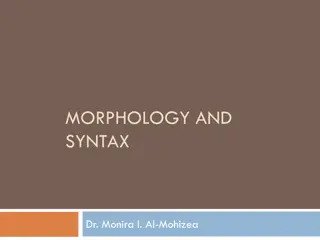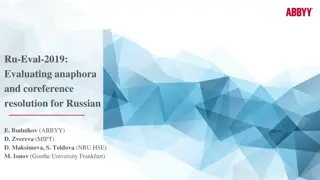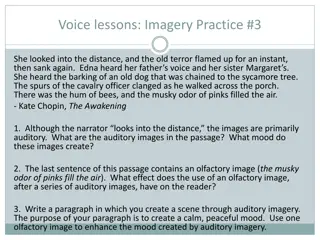SYNTACTIC CONSTRUCTIONS (I)
Different types of syntactic constructions, including endocentric and exocentric constructions, and the classification based on the grammatical relations between constituents. It also discusses the various levels of syntactic analysis, such as phrases, clauses, and sentences. The article provides ex
4 views • 11 slides
Ways of Enlarging the Vocabulary of a Language Word-Formation and Borrowing in Modern English.
Explore various types of word-building processes in Modern English, including morphological, syntactic, and mixed methods like affixation, composition, conversion, and borrowing. Understand the classifications of affixes, techniques in morphological word-building, and the diversity of the English vo
2 views • 31 slides
Understanding Syntax in Theoretical Grammar
Syntax, as a branch of theoretical grammar, explores the combination of words in phrases and sentences, focusing on their relationships and functions in communication. Basic syntactic notions, such as syntactic units, syntactic meaning, and syntactic relations, play a crucial role in shaping the str
5 views • 17 slides
Static Analysis Techniques Overview
Explore static analysis techniques such as syntactic analysis, dataflow analysis, and model checking. Understand the concept of basic blocks in static analysis and their boundaries. Dive into the opportunities provided by static analysis in summarizing program behavior without executing it.
9 views • 27 slides
Understanding Language Syntax Through Syntax Trees
Explore how both programming languages and spoken languages can be parsed into syntax trees, revealing the syntactic structure of sentences. Learn about terminals and non-terminals in syntax trees and how they represent different components of language. Dive into syntax tree abstraction for a deeper
3 views • 32 slides
Linguistics: Exploring Language Structure and Morphology
Linguistics is the scientific study of language and speech, encompassing branches like phonology, lexicology, and morphology. This field delves into the levels of language structure, such as phonological, morphological, lexical, syntactic, semantical, pragmatical, and stylistical. Scholars began inv
8 views • 7 slides
Understanding Notional Parts of Speech: Adjectives and Adverbs
Exploring the notional parts of speech, this text delves into the properties and functions of adjectives and adverbs. Adjectives describe the qualities of substances, while adverbs characterize actions or qualities. Adjectives can be qualitative or relative, with degrees of comparison, while adverbs
1 views • 25 slides
Understanding Lexical Sense Relations and Word Meanings
Investigating sense relations between words involves exploring synonyms, antonyms, hyponymy, and meronymy to understand the meanings of words in different contexts. By examining semantic similarities and syntactic relationships, one can better comprehend how words relate to one another, leading to a
0 views • 28 slides
Understanding Syntax and Grammar Components
Syntax is a vital subcomponent of grammar that involves studying the internal structure and relationship of phrases and sentences. Grammar components include Lexicon/Vocabulary, Phonological Form, Syntactic component/Grammar, and Logical Form. Constituents are parts that combine to form a whole stru
2 views • 40 slides
Understanding Ambiguity in Natural Language Processing (NLP)
Natural Language Processing (NLP) faces challenges with ambiguity, which occurs due to multiple possible interpretations of language input. Humans can often resolve ambiguity, but it's complex for computers. Types of ambiguities include lexical, syntactic, pragmatic, referential, and transient. Over
2 views • 24 slides
Understanding Semantics: The Study of Meaning in Linguistics
Semantics is the scientific study of meaning in language, delving into questions about definitions, ideas, objects, relations between meanings, and how meanings interact with syntactic rules. Exploring the vagueness of the term "meaning," semanticists explore sense, reference, denotation, and connot
2 views • 19 slides
Understanding Semantic Roles in Sentence Structure
Semanticists analyze sentences based on semantic structure rather than traditional syntactic terms like subject and object. Instead, they use semantic terms such as Agent, External causer, Instrument, Affected, Recipient, and Locative. These terms help describe how people and things participate in r
1 views • 26 slides
Syntactic Notions of the First Level in Linguistics
In this lecture, the syntactic notions of the first level in linguistics are discussed, focusing on word groups, simple sentences, and the essential features of actual division. The different types of syntagmatic groupings of words, such as notional words, functional words, and their combinations, a
1 views • 19 slides
Understanding English Parts of Speech and Tagging
English Parts of Speech and Tagging involve analyzing syntactic functions and semantic types of words in a sentence. This process assigns POS tags to each word based on its role in the sentence, such as nouns, verbs, adjectives, adverbs, prepositions, determiners, pronouns, and conjunctions. The dis
4 views • 43 slides
Overview of Subprograms in Software Development
Subprograms in software development provide a means for abstraction and modularity, with characteristics like single entry points, suspension of calling entities, and return of control upon termination. They encompass procedures and functions, raising design considerations such as parameter passing
4 views • 25 slides
Understanding MetaMap: Overview of Concepts and Functionality
MetaMap is a concept mapping program developed by Pawel Matykiewicz and others. It assists in mapping medical terms to concepts in the UMLS database. The program involves input formats, the algorithm, MetaMap options, output formats, and creators. Key features include parsing using SPECIALIST tools,
5 views • 24 slides
Advancements in Word Embeddings through Dependency-Based Techniques
Explore the evolution of word embeddings with a focus on dependency-based methods, showcasing innovations like Skip-Gram with Negative Sampling. Learn about Generalizing Skip-Gram and the shift towards analyzing linguistically rich embeddings using various contexts such as bag-of-words and syntactic
0 views • 39 slides
Exploring Translation Techniques and Levels
Delve into various translation techniques such as amplification, false friends, explicitation, and generalization, as exemplified by Vinay and Darbelnet. Discover the concept of loss, gain, and compensation in translation, along with the different levels of translation, including lexicon, syntactic
0 views • 16 slides
Understanding Syntax Through Jabberwocky and Linguistic Examples
Exploring the whimsical "Jabberwocky" poem alongside linguistic concepts like syntactic categories, nouns, verbs, and adjectives. Dive into the world of language structure and analysis with engaging examples.
0 views • 11 slides
Understanding Morphology and Syntax in English Language
This content explores morphology and syntax in English language, covering topics like conversion, compounding, and the formation of words through various linguistic processes. It delves into examples of verb-noun conversions, productive word formation methods, and compound words. The discussion also
0 views • 27 slides
Supporting Children in Developing Reading Skills
Understand the essential role of a parent as a co-reader in fostering children's reading abilities. Learn about decoding text using grapho-phonics, semantic, and syntactic approaches. Discover how to support children with phonics when reading, including breaking down words and blending sounds. Utili
0 views • 13 slides
Understanding Symbol Table Management in Program Compilation
Symbol table management is crucial in program compilation as it involves gathering information about names and constants, constructing storage structures, and aiding different phases like lexical and syntactic analysis, semantic analysis, code generation, and error handling. The symbol table serves
0 views • 22 slides
Understanding Language Principles: Semantic and Syntactic Analysis
Language users rely on semantic principles like open choice and idiom to understand utterances, while syntactic analysis helps in grasping sentence structure. The interplay between lexical and phraseological features shapes language comprehension, showcasing tensions like in aspectual and idiomatic
0 views • 16 slides
Building interactive interpreter for Calculator Language with REPL, Parsing, and Lexical Analysis
This project involves creating a user interface similar to a Read-Eval-Print Loop (REPL) for programming languages. Users can input text representations of expressions, which are then parsed, evaluated, and errors are handled accordingly before displaying the expression's value. Additionally, the st
0 views • 22 slides
Russian Anaphora and Coreference Resolution Evaluation
The Ru-Eval-2019 project evaluates anaphora and coreference resolution for Russian text. It discusses the task definition, existing corpora, and introduces a new corpus from OpenCorpora.org. The project focuses on coreference resolution to determine which mentions in a text refer to the same entity,
0 views • 21 slides
Literary Analysis: Imagery, Syntax, Diction, and Detail in Voice Lessons
Explore the use of auditory and olfactory imagery in Kate Chopin's "The Awakening," analyze the syntactic structure in Edgar Allan Poe's "The Black Cat," understand the nuances of diction, and delve into Winston Churchill's portrayal of King Henry VIII through contrasting details. Engage with questi
0 views • 22 slides
Verbal Mismatch and Phonological Identity in Peripheral Ellipsis
The study delves into verbal mismatch and phonological identity in peripheral ellipsis, covering topics such as syntactic mismatches, peripheral ellipsis and mismatch, and stricter identity requirements in peripheral ellipsis compared to other types of ellipsis. Various examples and analyses are pre
0 views • 49 slides
Overview of OWL 2 Web Ontology Language Features
Introduction to OWL 2, its extension from OWL 1.1, and compatibility, new features based on real applications and use cases, adoption as a W3C recommendation in 2009, and the rationale behind features like syntactic sugar, new constructs, extended datatypes, and punning.
1 views • 63 slides
Understanding Tibbles in R Programming
Tibbles are a modern way to work with data frames in R, offering enhanced functionality and ease of use. Learn how to coerce regular data frames to tibbles, their refined printing method, creating tibbles from individual vectors, handling non-syntactic column names, and using tribble for data entry.
0 views • 20 slides
Structural Assessment and Blade Design Iteration Tool Development
A spreadsheet tool was created to assess the structural viability of a proposed blade shape, incorporating a sandwich beam model with UD sparcaps and syntactic foam core. Validation of the beam model against FEA results was conducted, highlighting the relationship between beam thickness, spar width,
0 views • 10 slides
Understanding Grammatical Functions in Syntax
The study of syntactic forms and grammatical functions is crucial in analyzing sentence structures. This includes identifying subjects, objects, modifiers, and predicates. Various tests can be employed to determine grammatical functions, such as agreement, tag questions, and subject-auxiliary invers
0 views • 40 slides
Unpacking the Notions of Intelligence and Social Hegemony
This presentation delves into the complex concepts of intelligence and social hegemony, exploring historical perspectives, scholarly debates, and folk beliefs. It challenges the hegemonic nature of contemporary intelligence definitions and examines the power dynamics within civil society. Through a
1 views • 14 slides
Syntactic Reconstruction from Linguistic Fossils in Uralic Languages
Linguistic fossils provide valuable insights for syntactic reconstruction in Uralic languages like Hungarian, Eastern Khanty, and Samoyedic. Through a case study, constraints on topical objects and grammatical systems are examined using linguistic fragments.
0 views • 34 slides
Syntax in Language Acquisition: Root Infinitives and Small Clause Hypothesis
Children's syntactic development in language acquisition progresses from one-word utterances to combining words into basic sentences. This stage shows missing elements like tense, subject agreement, and auxiliary verbs. The Small Clause Hypothesis suggests that children initially lack certain struct
0 views • 52 slides
Understanding Debugging in High-Level Languages
Debugging in high-level languages involves examining and setting values in memory, executing portions of the program, and stopping execution as needed. Different types of errors – syntactic, semantic, and algorithmic – require specific debugging approaches. Syntactic errors are related to code l
0 views • 9 slides
Understanding Syntactic Transitivity in Estonian Language
This presentation by Natalia Vaiss from Tallinn University delves into the intricate details of syntactic transitivity types and the usage of direct objects, particularly focusing on partitive-accusative alternations in the Estonian language. It explores the morphological aspects of genitive and nom
0 views • 41 slides
Evolution of Syntactic Theory: From Psychology to Cognition
Syntactic theory has evolved significantly, influenced by psychology and cognition. The debate between phrase structure and dependency structure continues, with a shift towards integrating cognitive principles. Cognitive linguistics, including Cognitive Grammar and Construction Grammar, play a key r
0 views • 31 slides
Challenges of Syntactic Variation in Biblical Hebrew
Linguistic variation in Biblical Hebrew has sparked a heated debate since 2000, challenging traditional dating methods and assumptions. The Structure Debate delves into syntactic variation and the use of the participle, while considering the differing language in Early Biblical Hebrew (EBH) and Late
0 views • 21 slides
Translation Strategies and Principles for Effective Communication
This content covers features and principles of good translation, problems encountered in translation such as lexical and syntactic issues, degrees of approximation, typologies of translation strategies, and the significance of syntactic, semantic, and pragmatic components in translation. It also dis
0 views • 29 slides
Understanding Syntax in Linguistics
Words in a language are organized into phrases and clauses with specific syntactic categories like Noun Phrase, Verb Phrase, and Adjective Phrase. Each phrase has a head such as a noun, verb, or adjective, and phrase structure rules help diagram the syntactic structure. Clauses are the largest units
0 views • 20 slides







































